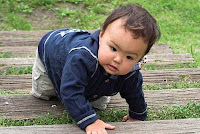Movement is encouraged and the Montessori environment is specifically designed to accommodate the variety of developmental movement milestones that occur within the first three years of life. Learn more about how the Montessori prepared environment is set up to encourage and stimulate movement and motor skills for the infant or toddler.
Motor Skills and Movement in the Infant / Toddler Montessori Prepared Environment
Children are free to move and explore as they are developmentally ready. The Montessori Infant/Toddler environment is specially prepared to accommodate babies who are not yet mobile as well as toddlers who have a fully developed sense of mobility. There is plenty of open floor space with low shelves which encourage exploration. There are mirrors hung horizontally at floor height so babies may explore who they are, and mirrors hung at toddler height. For those who are more mobile, there are climbing stairs and slides.In the Montessori Infant/Toddler environment, instead of cribs, sleeping mattresses placed on the floor or low cots are used so children can get into and out of by themselves. Tables and chairs are child-sized and light enough to be easily moved by children. Bookshelves are low, allowing accessibility to children while maintaining visibility by adults at all times. Coat hooks are hung at child height so children are able to hang and remove their own coats. Sinks are at various heights to accommodate various ages and heights. And of course, there are one or two adult rocking chairs used to feed infants or comfort children.
Eating is a social experience. In the Montessori Infant/Toddler environment, eating areas are designed to accommodate the different skills and abilities of children under three. Bottle-fed infants are held while being fed. Many Montessori infant facilities provide a dimly lit and quiet space for nursing mothers to nurse their babies. As soon as an infant can sit up with support, she can be fed at a low table. Typical high chairs are not used. Instead, specially designed infant chairs which are low enough for the child to get in and out of by themselves. Unlike other chairs in the Montessori environment, these chairs are heavy and not easily moved or tipped over. The Montessori caregiver feeds the child sitting on a low stool, facing the child and places the food dish on the table in front of her. As soon as they are able, children are given the opportunity to feed themselves, practicing and mastering their developing movement skills. Once the infant can walk, she is invited to eat with other children, sitting around the table in a chair more suited for her developing needs.
The Montessori outdoor environment must be just as carefully planned. The outdoors provides many natural and beautiful sensory experiences for even the youngest of children. Babies may be placed on a blanket in the grass to absorb the sounds and smells of nature. Older babies may enjoy feeling the texture of the grass or the sound of crunching leaves. Toddlers will become absorbed watching ants crawl across the path. It is not necessary to purchase expensive playground equipment. Many Montessori outdoor Infant/Toddler environments have a sandbox and sand toys such as shovels, rakes, buckets, and watering cans. In addition to developing movement, sandboxes are a great place to develop social skills! Other outdoor features may include a small hill for walking and running up and down, a low platform for climbing, large tires to climb on and sit in, and wide, heavy boards of various lengths to balance on.
Here are few simple points in summary with respect to planning the Montessori Infant/Toddler environment:*
- Children are free to move and explore as they are developmentally ready. A place for keeping non-mobile infants safe while they are lying on the floor, but which allows them to see and hear others in the environment
- Quiet space for presentations or independent activities
- Quiet listening area
- An area for older toddlers and two year olds to work with building blocks
- A well-lit, comfy corner for reading books
- A quiet place to feed or rock infants
- A diapering/toileting area
- An outdoor space with a variety of hard and soft surfaces and objects.
*Special note: Please check your local licensing agencies for area specific guidelines regarding diapering/toileting, sleeping and eating arrangements.
See our other related blogs in this series:
- Montessori Musings: Development of Movement in Children
- Independence and Movement: Montessori Preschool
- Independence and Movement: Montessori Elementary
As much as possible, NAMC’s web blog reflects the Montessori curriculum as provided in its teacher training programs. We realize and respect that Montessori schools are unique and may vary their schedules and offerings in accordance with the needs of their individual communities. We hope that our readers will find our articles useful and inspiring as a contribution to the global Montessori community.
© North American Montessori Center - originally posted in its entirety at Montessori Teacher Training on Wednesday, March 31, 2010.
© North American Montessori Center - originally posted in its entirety at Montessori Teacher Training on Wednesday, March 31, 2010.



Excellent information, very well written and researched. I like the description of the infant/toddler environment; teaching them to do things themselves at an early an age as possible. I would love to see my daughter in a place like this. I look forward to your next article.
ReplyDeleteThank you, Tim, for your kind remarks. The best way to choose a Montessori school for your daughter is to call the local Montessori schools and schedule a time to observe in a classroom. For guidelines on what to look for in a Montessori school as well as helpful observation tips, you may wish to read the following:
ReplyDeletehttp://montessoritraining.blogspot.com/2008/01/choosing-right-montessori-school.html
http://montessoritraining.blogspot.com/2008/01/guidelines-for-observing-in-montessori.html